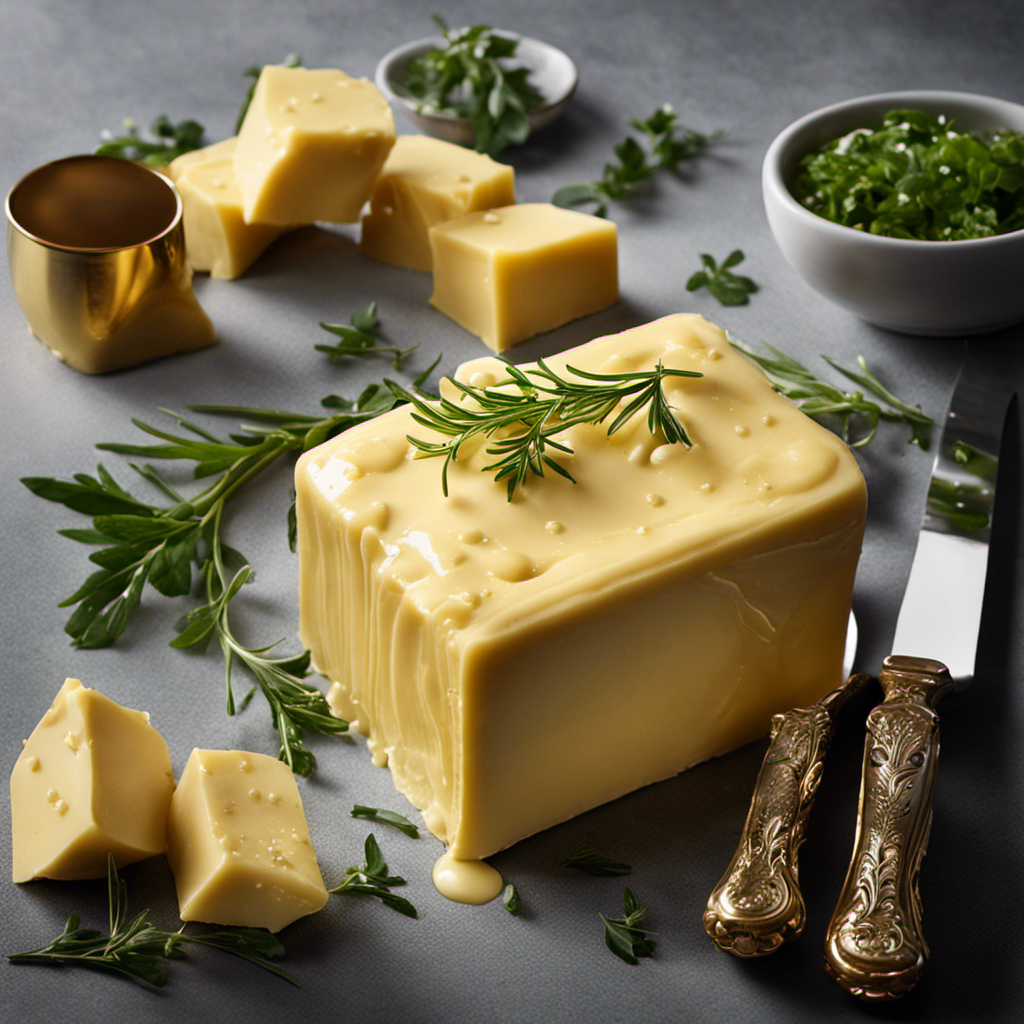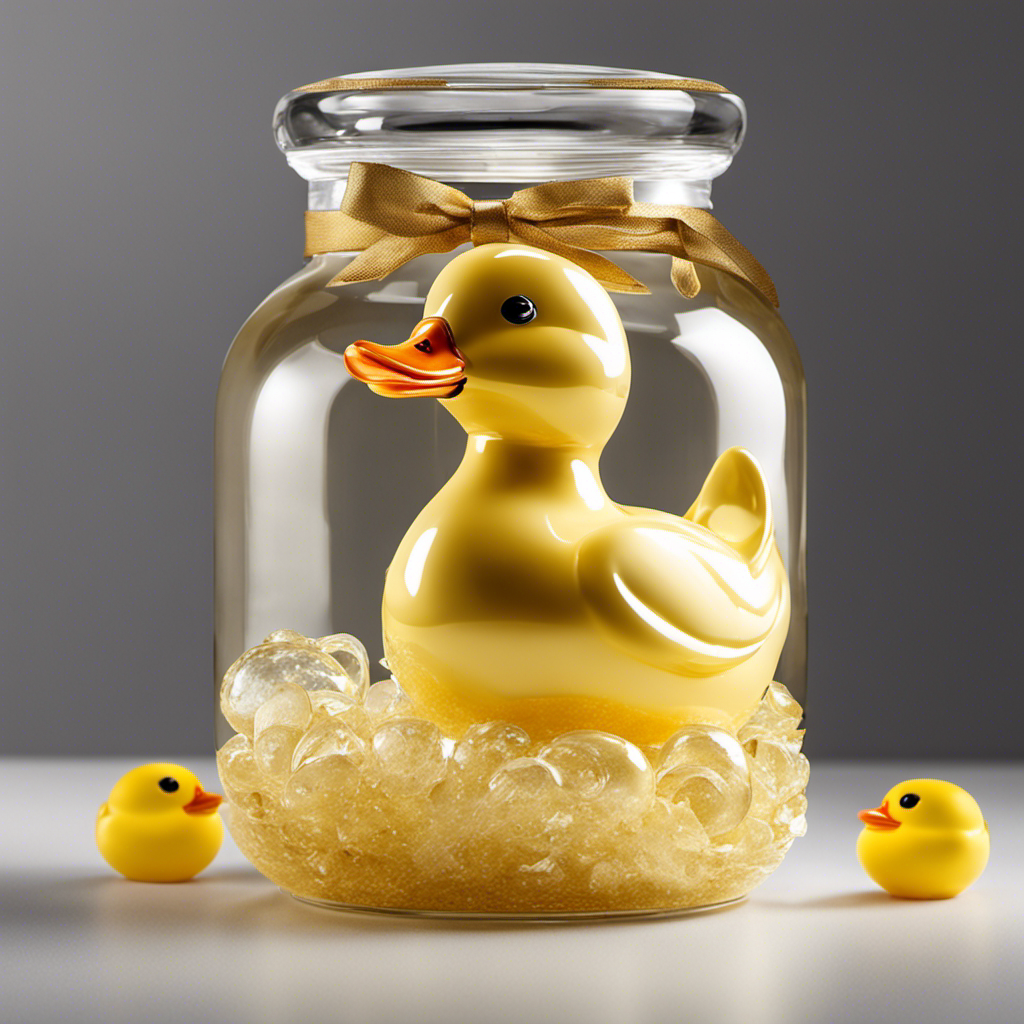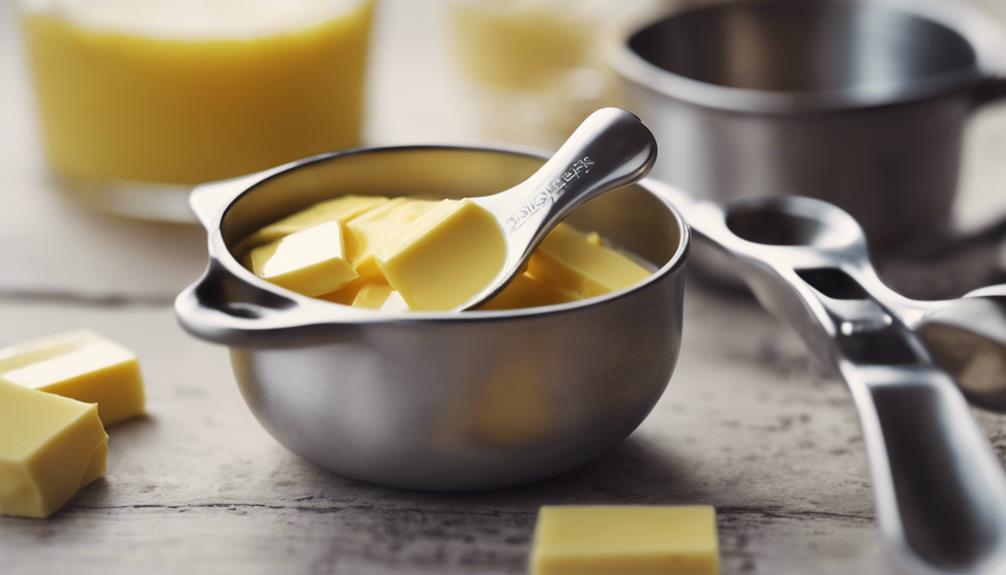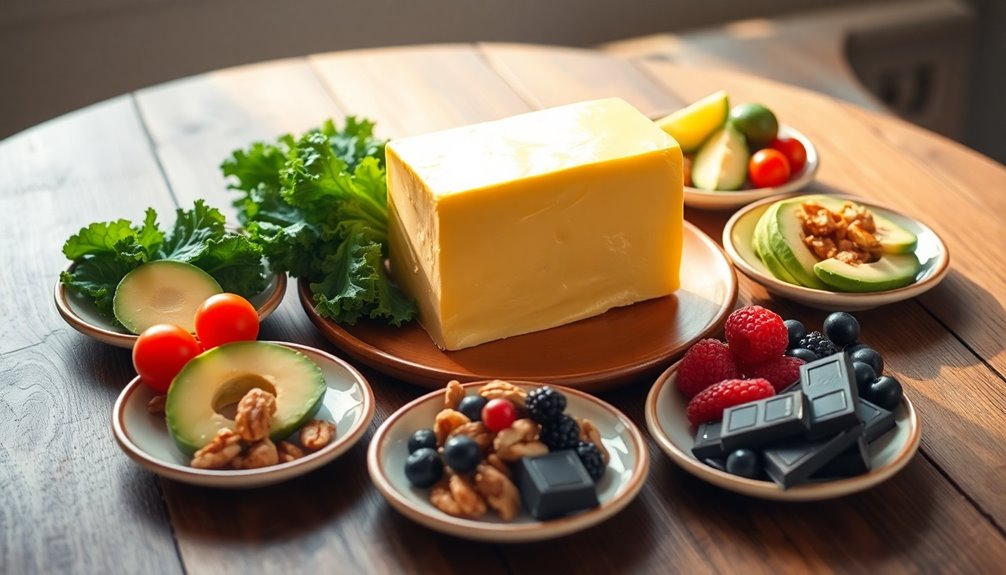As a lover of the culinary arts, I have always been convinced that butter makes everything better.
But imagine butter elevated to a whole new level of decadence and flavor. That’s where Epicurean Butter comes in.
With its rich history, carefully selected ingredients, and meticulous process, Epicurean Butter takes ordinary dishes and transforms them into extraordinary culinary creations.
Join me as we explore the world of Epicurean Butter, its delightful flavors, and the countless ways it can enhance your cooking experience.
Key Takeaways
- Epicurean butter is a beloved ingredient in cuisines worldwide, with a rich history and cultural significance.
- The unique flavor combinations of epicurean butter, created with carefully selected high-quality ingredients, enhance the taste of dishes.
- Sourcing high-quality ingredients and practicing sustainability are crucial in the production of epicurean butter.
- Proper storage and creative usage of epicurean butter ensure its best taste and quality, while its versatility makes it suitable for a wide variety of recipes.
History of Epicurean Butter
The history of Epicurean Butter dates back to ancient Greece, where it was first created by Epicurus himself. Butter has been a staple in human diets for centuries, and its production has evolved over time.
In ancient times, butter was made by churning milk, a process that involved separating the cream from the milk and then agitating it until it formed into butter. This method of butter production was passed down through generations and eventually spread to other cultures.
Butter holds cultural significance in many societies. It is often associated with indulgence, richness, and decadence. In ancient Greece, butter was not only used for cooking but also had symbolic value in religious ceremonies.
Its creamy texture and delicious flavor have made it a beloved ingredient in cuisines around the world.
Ingredients Used in Epicurean Butter
When it comes to creating epicurean butter, I believe that the unique flavor combinations are what truly set it apart from other butters.
The combination of ingredients like herbs, spices, and even fruits creates a symphony of flavors that elevate any dish.
And let’s not forget about the importance of sourcing high-quality ingredients – it’s crucial to ensure that every bite of epicurean butter is bursting with the freshest and most delicious flavors.
Unique Flavor Combinations
Combining different flavors in epicurean butter creates unique and delicious taste experiences.
As a culinary enthusiast, I have always been fascinated by the endless possibilities that come with experimenting with flavors. Epicurean butter allows me to take my love for cooking to a whole new level.
The unique flavor pairings that can be achieved with epicurean butter are truly remarkable. Whether it’s the subtle sweetness of caramelized onions combined with the richness of roasted garlic, or the zesty kick of lemon zest mixed with the earthiness of thyme, the culinary applications are endless.
These flavor combinations elevate any dish, from simple grilled vegetables to succulent grilled steak. The versatility and depth of flavor that epicurean butter brings to the table is truly a game-changer in the world of culinary arts.
Quality Sourcing of Ingredients
You can ensure the highest quality in your flavor combinations by sourcing the freshest and finest ingredients available. When it comes to creating epicurean butter, the sourcing of ingredients is crucial.
Here are some key factors to consider:
-
Sustainability practices: Choosing ingredients from sustainable sources not only helps protect the environment but also ensures a long-term supply of high-quality ingredients.
-
Seasonality: Opting for ingredients that are in season guarantees their peak freshness and flavor, resulting in a more vibrant and delicious butter.
-
Local produce: Supporting local farmers and producers not only contributes to the community but also allows for ingredients that are grown or produced nearby, minimizing transportation time and preserving flavor.
-
Organic options: Opting for organic ingredients means you’re avoiding harmful chemicals and pesticides, which can have a negative impact on flavor profiles.
-
Artisanal craftsmanship: Selecting ingredients that are crafted with care and attention to detail by skilled artisans adds a unique touch to your epicurean butter, elevating its flavor and quality.
The Process of Making Epicurean Butter
The first step in making Epicurean Butter is to melt the butter in a saucepan.
As the butter slowly heats up, it transforms into a golden liquid, releasing its rich aroma and creating a velvety texture.
Once melted, the butter is carefully strained to remove any impurities, ensuring a smooth and pure final product.
Next, the melted butter is cooled to a specific temperature and whipped to incorporate air, creating a light and creamy texture. This process step is crucial in achieving the desired consistency of Epicurean Butter.
Finally, the butter is flavored with a variety of high-quality ingredients, such as herbs, spices, or truffles, using precise production techniques.
These flavors perfectly complement the richness of the butter, resulting in a truly decadent culinary experience.
Different Flavors of Epicurean Butter
There are various flavors available for Epicurean Butter, including ones infused with herbs, spices, and even truffles. This luxurious butter is a culinary delight that elevates any dish to a whole new level.
Here are some flavor pairing ideas to inspire your taste buds:
-
Classic Garlic and Herb: Perfectly seasoned with aromatic garlic and fragrant herbs, this butter adds a burst of flavor to roasted vegetables, grilled meats, or simply spread on warm bread.
-
Lemon Garlic: The bright citrus notes combined with the richness of garlic make this butter ideal for seafood dishes like grilled shrimp or baked salmon.
-
Black Truffle: Indulge in the earthy and decadent flavor of black truffles. Use it to enhance pasta dishes, risottos, or even scrambled eggs for a truly gourmet experience.
-
Smoked Paprika: The smoky and spicy flavor of paprika adds depth and complexity to grilled meats, roasted potatoes, or even a simple bowl of popcorn.
-
White Wine and Shallot: This butter is infused with the delicate flavors of white wine and shallots, making it the perfect accompaniment to pan-seared scallops, grilled chicken, or sautéed vegetables.
Not only do these flavors enhance your dishes, but Epicurean Butter also offers health benefits. It is made with high-quality ingredients, such as grass-fed butter and natural herbs, which provide essential vitamins and minerals. Additionally, the use of real ingredients means no artificial flavors or preservatives. So, not only will your taste buds thank you, but your body will too.
Benefits of Using Epicurean Butter in Cooking
Now that we’ve explored the delectable flavors of Epicurean Butter, let’s dive into the many benefits of using this culinary delight in your cooking.
One of the greatest advantages of using flavored butter is the burst of flavor it adds to any dish. Whether you’re sautéing vegetables, searing a steak, or spreading it on freshly baked bread, Epicurean Butter elevates the taste to new heights.
But it’s not just about the taste. Butter alternatives, like Epicurean Butter, also offer health benefits. Made from all-natural ingredients, they are free from artificial preservatives and additives. Additionally, Epicurean Butter contains essential fatty acids, vitamins, and minerals that are beneficial for your overall well-being.
How to Store Epicurean Butter Properly
To properly store your Epicurean Butter, make sure to keep it in the refrigerator at all times. This will help maintain its freshness and extend its shelf life. Here are some tips to ensure proper storage:
- Store the butter in an airtight container or its original packaging to prevent it from absorbing odors from other foods in the fridge.
- Keep the butter away from strong-smelling foods, as it can easily pick up their flavors.
- Make sure the temperature of your refrigerator is set below 40°F (4°C) to keep the butter solid and prevent it from melting.
- Avoid storing the butter in the refrigerator door, as it is exposed to temperature fluctuations when the door is opened frequently.
- Check the expiration date on the packaging and use the butter before it expires for the best taste and quality.
Now that you know how to store your Epicurean Butter properly, let’s explore some creative ways to use it in recipes.
Creative Ways to Use Epicurean Butter in Recipes
If you’re looking for creative ways to incorporate it into your recipes, try using Epicurean Butter as a flavorful base for sautéing vegetables or as a spread for toast. This luxurious butter is infused with unique and delicious flavors that will elevate any dish.
One of my favorite recipe ideas is to use the Lemon Garlic Herb Epicurean Butter to sauté asparagus with a sprinkle of Parmesan cheese. The tangy lemon and savory garlic perfectly complement the earthy flavors of the asparagus.
Another great idea is to spread the Black Truffle Epicurean Butter on a warm slice of crusty bread and top it with thinly sliced radishes and a sprinkle of sea salt. The rich truffle flavor adds a touch of elegance to this simple snack.
Not only does Epicurean Butter add incredible taste to your recipes, but it also offers health benefits. Made with real, high-quality ingredients, it is a great source of healthy fats and vitamins.
Customer Reviews and Testimonials About Epicurean Butter
When it comes to customer experiences, authenticity and product quality are key factors that can make or break a brand.
Positive customer experiences are crucial in building trust and loyalty, and they often stem from genuine interactions and high-quality products.
Authenticity plays a significant role in creating a genuine connection with customers, as it shows that a brand is true to itself and its values.
Lastly, product quality is essential in delivering on promises and ensuring customer satisfaction.
When all these elements align, it creates a recipe for success in the competitive world of business.
Positive Customer Experiences
You’ll love the positive customer experiences people have had with Epicurean Butter. Here are some reasons why customers rave about our products:
-
Enhanced flavors: Epicurean Butter adds a rich and creamy taste to any dish, elevating the flavors to new heights.
-
Versatile ingredient: From spreading on toast to cooking and baking, Epicurean Butter is a versatile ingredient that can be used in a wide variety of recipes.
-
Time-saving convenience: Our butter blends are pre-mixed with herbs, spices, and other flavors, saving you time and effort in the kitchen.
-
Exceptional quality: Made with premium ingredients and crafted with care, Epicurean Butter ensures a high-quality product every time.
-
Endless creativity: With Epicurean Butter, your culinary possibilities are endless. Try it in creative recipes like garlic herb mashed potatoes, lemon dill salmon, or truffle mac and cheese.
Join the ranks of satisfied customers who have experienced the benefits of using Epicurean Butter and get ready to unleash your creativity in the kitchen.
Authenticity and Product Quality
Experience the authentic and high-quality flavors that our products have to offer.
When it comes to product authenticity and butter quality, we take pride in delivering only the best to our customers. Our butter is made from the finest, locally sourced ingredients, ensuring that each bite is a taste of perfection.
We carefully churn and culture the cream to create a rich, creamy texture that melts effortlessly on your tongue. The flavor is unparalleled, with a subtle sweetness and a hint of salt that enhances any dish.
Whether you’re spreading it on warm toast or using it to create a decadent sauce, our butter will elevate your culinary creations to new heights.
Trust in our commitment to quality and authenticity, and let our butter take your taste buds on a journey they won’t soon forget.
Where to Buy Epicurean Butter and Pricing Information
You can easily find and purchase Epicurean Butter at various retailers, and the pricing information is readily available. Whether you prefer to shop online or visit a physical store, there are plenty of options to choose from.
Here are some online retailers selling Epicurean Butter:
-
Amazon: With its vast selection and competitive prices, Amazon is a popular choice for purchasing Epicurean Butter. You can easily compare prices from different sellers and read customer reviews to make an informed decision.
-
Walmart: Known for its affordable prices, Walmart offers a range of Epicurean Butter products at competitive prices. You can enjoy the convenience of online shopping or visit a nearby store.
-
Target: Another popular retailer, Target carries a variety of Epicurean Butter flavors at reasonable prices. Their website provides detailed product descriptions and customer ratings to assist your purchasing decision.
-
Whole Foods: If you prefer organic and natural products, Whole Foods is a great option. They offer a selection of Epicurean Butter flavors at slightly higher prices, reflecting the quality and sourcing of their products.
-
Specialty Food Stores: Local specialty food stores often carry Epicurean Butter, providing a unique shopping experience and the opportunity to support local businesses.
When comparing prices of Epicurean Butter at different stores, it’s essential to consider factors such as shipping costs, discounts, and promotions. Don’t forget to check for any loyalty programs or subscription options that could save you money in the long run.
Frequently Asked Questions
How Many Calories Are in Epicurean Butter?
In Epicurean Butter, there are approximately 80 calories per serving. The nutrition facts may vary depending on the flavor. The ingredients consist of high-quality butter blended with herbs, spices, and other natural flavors.
Is Epicurean Butter Suitable for Those With Dietary Restrictions or Allergies?
Yes, Epicurean Butter is suitable for those with dietary restrictions or allergies. Made with high-quality ingredients, it offers a delicious and allergen-free option. It’s perfect for anyone looking to enjoy a flavorful butter without any worries.
Can Epicurean Butter Be Used as a Substitute for Regular Butter in Recipes?
Using epicurean butter as a substitute in recipes adds a touch of culinary magic. Its rich flavor and creamy texture elevate any dish. Plus, it’s easy to use in baking – just swap it in for regular butter and enjoy the delicious benefits!
Are There Any Preservatives or Artificial Additives in Epicurean Butter?
No, Epicurean Butter is preservative free and made with only natural ingredients. It’s a delicious and healthier alternative to regular butter that adds a burst of flavor to any recipe.
Can Epicurean Butter Be Used for Both Sweet and Savory Dishes?
Yes, Epicurean Butter is incredibly versatile. It adds a rich, creamy flavor to both sweet and savory dishes. From decadent desserts to savory sauces, this butter elevates any recipe to a whole new level.
Conclusion
After delving into the world of Epicurean Butter, I am truly amazed by its rich history, unique flavors, and the countless benefits it brings to cooking.
It’s fascinating to learn that Epicurean Butter has been satisfying palates for over 30 years, becoming a staple in kitchens across the country. With its wide range of flavors, from Roasted Garlic Herb to Lemon Garlic Herb, there’s something for everyone’s taste buds.
What’s even more impressive is that Epicurean Butter has received an average rating of 4.8 out of 5 stars from satisfied customers, a testament to its quality and deliciousness. This statistic truly highlights the exceptional nature of Epicurean Butter and why it’s a must-have for any culinary enthusiast.










